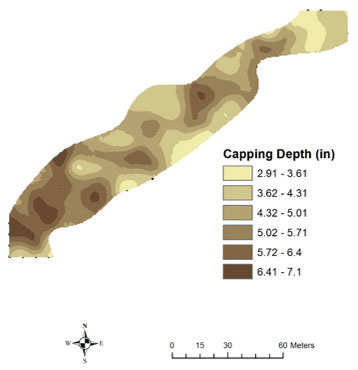Data-driven irrigation scheduling techniques for sand-capped fairways

Krigged map extrapolating capping depth from a 20-foot-by-20-foot sampling grid. (Figure: Reagan Hejl)
With current strains on water resources and with the increasing trend of capping degraded golf fairways with sand, the golf industry needs research toward efficient methods for irrigation management on sand-capped soil. While Reference ET-based scheduling — based as it is on weather data — provides an effective means of predicting irrigation requirements, reliable access to locally representative data is often a barrier for implementation.
The recent availability of open-access NOAA Forecasted Reference ET (FRET) data provides ET data regardless of proximity to a weather station and offers superintendents another tool for managing irrigation. Unfortunately, research is lacking on how FRET values compare to the standard Penman-Monteith ETo at given locations.
Field observations by turf managers suggest variability in turf performance on sand-capped soil is due to variation in water availability. In-ground soil moisture sensors (SMS) could be a potential tool to alleviate some of the variability. A field study is under way on newly constructed sand-capped plots at the Texas A&M Turfgrass Field Research Laboratory in College Station, Texas. The study is evaluating turf performance and water savings potential of four irrigation scheduling techniques, including: 1) wireless SMS, 2) Penman-Monteith Reference ETo, 3) FRET and 4) visual wilt-based approach.
A companion study is being conducted at a nearby golf course to explore factors influencing soil moisture variability in sand-capped fairways. Potential sources of variability being examined include capping depth, subgrade texture, surface organic matter levels, proximity to sprinkler heads and elevation/slope. So far, capping depth across three fairways have been sampled, and despite a targeted 5-inch depth at construction, considerable spatial variability has been identified.
Reagan Hejl, research associate and Ph.D. candidate, Benjamin Wherley, Ph.D., turfgrass scientist, Kevin McInnes, Ph.D., soil physicist, and Rebecca Grubbs, Ph.D., turfgrass scientists are at Texas A&M University. You may reach Reagan at Reagan.hejl@tamu.edu for more information.










